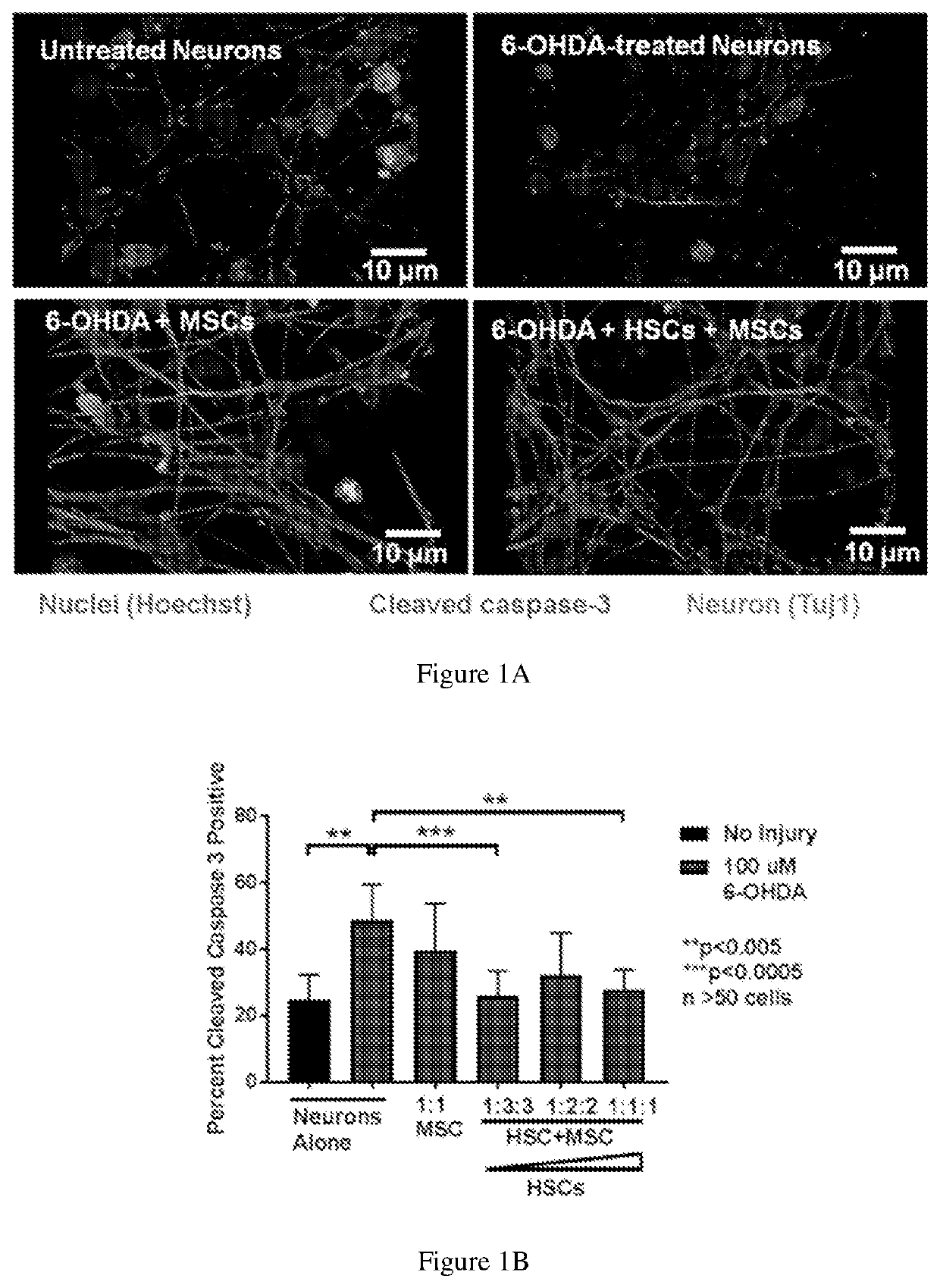Dual Stem Cell Therapy for Neurological Conditions
a stem cell therapy and neurological technology, applied in the field of parkinson disease cellular compositions and methods, can solve the problems of unproven control or reversal of pd clinical symptoms of mscs to date, unexpected relative failure of mscs in human pd trials, and limited efficacy of existing therapies in long-term control or reversal of disease progression
- Summary
- Abstract
- Description
- Claims
- Application Information
AI Technical Summary
Benefits of technology
Problems solved by technology
Method used
Image
Examples
example 1
SC Purification from UBS and Ex Vivo Expansion
[0078]The purpose of this Example is to describe an exemplary procedure for isolating mononuclear cells from umbilical cord blood and for isolating potential mesenchymal stromal cells that might have become attached to the inner surfaces of the cord blood collection bag, and to isolate CD133+ hematopoietic stem cells from the same unit.
[0079]Make sure cord blood tubing is inside of a 50 mL falcon tube, lift bag at an appropriate angle so blood flows naturally into tube. Drain 50 mL into each tube. Dilute 25 mL of blood with 25 mL of PBS (1:1 blood to PBS dilution). After dilution, turn tubes upside down 3-4 times to mix together. Pipet 15 mL of Ficoll-Paque density gradient medium into a 50 mL Sepmate Tube. Place the pipet tip against the vertex near the bottom of the tube. Slowly fill bottom of tube, make sure no bubbles are present. Very slowly pipet 25 mL of the diluted blood-PBS mixture into the 50 mL Sepmate tube that contains the F...
example 2
e for HSCs in Promoting Neurite Outgrowth
[0090]Neurites are extensions from the neuronal cell body that play a key role in the normal function of neurons and connectivity and communication between neurons. A hallmark of neuronal injury by hypoxia or environmental toxins such as 6-OHDA is damage to neurites, manifested as consolidation of neurite networks and degradation of neurites. Neurite outgrowth is a key process that contributes to regeneration and can be quantified by microscopic analysis. MSCs secrete neuronal growth promoting factors, however MSCs have only shown modest benefits for neurite outgrowth. The effects of HSCs on neurite outgrowth has not been studied, however HSCs secrete proteins including SDF-1, which have been shown to promote neurite outgrowth. This invention discloses that HSCs can enhance neurite outgrowth after injury.
[0091]LUHMES cells were maintained for less than 10 passages in T25 tissue culture flasks pre-coated with 50 ug / ml poly-L-ornithine (Sigma) ...
example 3
and HSC Cell Therapy
[0094]This Example provides allogeneic UCB derived dual stem cells (MSC / CD133+ HSC) biologic therapy with provision of optimal HLA match for each patient based on global UCB inventory search of clinical grade UCB networked via the National Marrow Donor Program.
[0095]FIGS. 1A-1B show that HSC enhance MSC-mediated regeneration of injured dopaminergic neurons. On Day 6 of differentiation, LUHMES Dopaminergic Neurons were treated with 100 uM 6-OHDA, co-cultured for 6 hours with varying doses of UCB MSC and autoMACS-selected CD133+ HSC, fixed and stained for Tuj1 and cleaved caspase 3, an early injury marker, and visualized on an Zeiss Axiovert Z1 equipped with Apotome.2. Data represent mean+ / −SD, Mann-Whitney U test.
[0096]MSC and HSC isolation and culture: Human UCB was collected into collection bags containing citrate dextrose (Allegiance, Deerfield, Ill.). Mononuclear cells were isolated by Ficoll-Paque PLUS (GE Healthcare Life Sciences, Piscataway, N.J.) density g...
PUM
| Property | Measurement | Unit |
|---|---|---|
| volume | aaaaa | aaaaa |
| volume | aaaaa | aaaaa |
| volume | aaaaa | aaaaa |
Abstract
Description
Claims
Application Information
 Login to view more
Login to view more - R&D Engineer
- R&D Manager
- IP Professional
- Industry Leading Data Capabilities
- Powerful AI technology
- Patent DNA Extraction
Browse by: Latest US Patents, China's latest patents, Technical Efficacy Thesaurus, Application Domain, Technology Topic.
© 2024 PatSnap. All rights reserved.Legal|Privacy policy|Modern Slavery Act Transparency Statement|Sitemap



